#adeni jews
Explore tagged Tumblr posts
Text

Adeni Jewish man with traditional headgear, southern Yemen, 1949
369 notes
·
View notes
Text

Rachel Nadav (1912-2003), likely 1940s.
"Israeli ballet dancer, born in Aden (Yemen). In 1933 Nadav joined the ballet company of the dancer and choreographer Rina Nikova, a pioneer classic ballet dancer in Eretz Israel. Nadav became leading dancer of Nikova's "Yemenite Ballet Company" and performed around the country and abroad. In the early 1940s she founded a ballet company and integrated classic dances with Yemenite dances, influenced by Nikova's school, and inspired by biblical texts." x
#teimanim#yemenite jews#yemeni jews#mizrahim#mizrahi jews#adeni jews#jewish women#jewish dance#jewish culture#mizrahi culture#swana jews#rachel nadav#israeli dance#israeli art#mizrahi#yemenite dancer#yemenite dance#ישראבלר#jewish history#mine#photography#israel#ישראל#uploads
18 notes
·
View notes
Text
In 2023, Tel Aviv celebrated its first ever Jachnun Festival. Celebrity pastry chefs, jachnun joints and hungry crowds gathered at the hip settings of the city’s harbor, enjoying every possible version of the humble star of the party, the Shabbat Yemenite pastry. Alongside classic jachnun, visitors could try stuffed jachnun, spelt flour jachnun and even gluten-free ones. A stand offered Yemenite spicy sauce (zhug) tastings, and another featured a chili pepper eating competition. And to wash it all down, jachnun lovers were offered spiced black coffee, and fig and date arak liquor.
Jachnun is a slightly sweet rolled pastry, made of very thin layers of dough that are brushed with clarified butter. It is the Shabbat dish of the Jews of Aden, in today’s Yemen, and is baked overnight on Friday at a low temperature then eaten for breakfast on Saturday morning.
Israeli food writers wondered how Tel Aviv hasn’t had a jachnun festival until now, but my question is quite different: How did this unassuming pastry make its way from Aden to the heart of Israeli culinary consensus in just 75 short years? It stands there in pride alongside other classics like shakshuka, schnitzel, hummus and chicken soup. When and how did that happen?
First, to clarify, the famous Yemenite jachnun is actually from Aden, not Yemen. (Aden, which was the capital of South Yemen, became part of the country now known as Yemen only in 1990 after the unification of North Yemen and South Yemen.) The Adenite and Yemenite (mainly from around Sana’a) Jewish communities were separate and had different traditions.
Adenite and Yemenite Jews met for the first time in the Hashed (or Geula, “redemption” in Hebrew) transit camp arranged by The American Jewish Joint Distribution Committee in 1949 ahead of Operation Magic Carpet that brought them to Israel.
“In Hashed, with ingredients brought by The Joint, is where Yemenites first learned from the Adeni how to make jachnun,” said Moshe David, an Israeli of Adanite roots, a jeweler and author of the cookbook “Disappearing Flavors of the South.”
“More Yemenites learned how to make the dish in the camps in Israel,” where Yemenite and Adenite Jews lived together for years, he told me.
For hundreds of years Aden was a cosmopolitan strategic harbor city. It was ruled by the Ottomans and then by the British. Moshe believes that jachnun originated from an Ottoman pastry called gül böreği (rose-shaped borek). The pastry is made with yufka, a thin dough, thicker than phyllo, that’s used for many Turkish pastries, and is stretched to an almost transparent leaf, then spread with fat, just like jachnun. The original gül böreği, though, is stuffed with meat, while jachnun is only brushed with fat and then rolled.
In the past, jachnun was actually served as a sweet dish, topped with honey (and later, in Israel, with sugar).
“They used to serve it with halva or Turkish delight,” said David. “That’s what convinced me the origin is Ottoman. They would also serve it with quince jam,” a testament of the Adenite connection to the Silk Road and Persian cuisine.
In search for the origins of the dish, I found an unusual version of jachnun in two of Molly Bar-David’s books. Bar-David was a Jewish American who emigrated to Israel in the 1940s and documented Jewish dishes of immigrants that arrived in Israel from all across the Jewish Diaspora. She quotes a recipe for ghihinoon (Yemenite Cakes) from her Yemenite housekeeper, Margalit, who used to sprinkle chopped nuts, jam or cottage cheese on the dough before rolling it and baking.
I should add that the 1964 book is packed with condescending comments toward the many Mizrahi and Sephardi Jews mentioned in the book. Margalit (last name is not provided) was not spared. In general, this was in line with the way many Ashkenazi Jews at the time viewed Jews from Arab and Muslim countries.
Moshe thinks that Bar-David mistakenly mixed g’hin, “dough” in Yemenite, with ghihinoon. But when I asked a Yemenite-Israeli Facebook group about it, one member said she too spreads the dough with jam before baking. Still, most Yemenite Israelis in the group found that idea amusing, and jokingly suggested serving jachnun with whipped cream and chocolate sauce.
Jachnun evolved into a savory course, and became nationwide phenomena, fairly recently, in the 1980s when a chain of Yemenite restaurants named Nargila (hookah) took Israel by storm. Nargila offered a limited menu, and jachnun and malawach were the stars. The pastries were served with grated tomatoes mixed with zhug, which became the standard for Yemenites and even for some Adenite Jews.
These days, jachnun is available in the freezer aisle at any supermarket in Israel, offering an inferior but easy option for those daunted by the labor-intense process of making the dish at home. On the weekends, fresh jachnun is readily available at pop-up roadside stands, cafes and even as part of the famous Israeli breakfast buffet in many hotels. This modest dish has officially become an Israeli staple.
17 notes
·
View notes
Photo
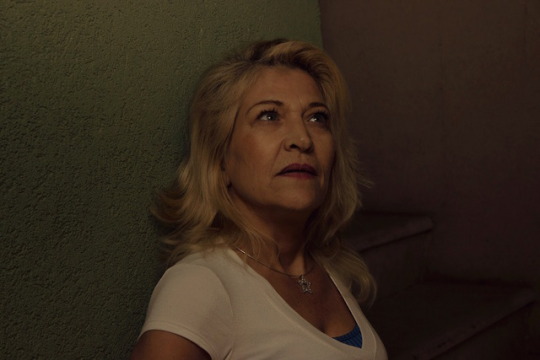
Focusing a New Lens on Mizrahiness
“Generation(s) of Levantines” by Leeor Ohayon
view the accompanying documentary photography series following the essay
“What exactly are you trying to capture? Which community? There just isn’t such a thing as Mizrahi,” my interviewee told me shortly. He had a point; what on earth was I trying to document?
Being of mixed Moroccan and Adeni heritage and having attended Jewish schools in London all my life, I became very much aware of the erasure of Mizrahi and Sephardic Judaism in the public realm. Jewish studies at school were conducted around an Ashkenazi-centric reading of history that began in Warsaw and ended with the Khurva synagogue in Jerusalem. Israeli Independence Day was celebrated with Klezmer music in the auditorium and dry falafel for lunch.
Mizrahi histories and cultures have been sacrificed at the altar of a collective Jewish imagination. That is to say-- our understanding of Judaism and Jewish memory is always conducted through the Ashkenazi experience, by Jews and non-Jews alike. The Ashkenazi label has become the default face of Judaism and Jewishness, and consequently is often found interchangeably replaced with just “Jewish.” Non-Ashkenazi cultures, in comparison, are hyphenated, asterisked, and put in boxes-- if not shelved entirely.
Perhaps that’s why heading to Israel to document Mizrahim proved to be my own Mizrahi education. I was confronted by the fact that my understanding, despite seeing myself as well versed in Mizrahi history, was coloured by my experience as a Mizrahi in the UK. Ashkenormativity alienates Mizrahim everywhere, but in Israel there is an entire political and social commentary surrounding this subject that often feels absent in the West.
When my interviewee asserted to me that there’s no such thing as “Mizrahi,” he was technically right. Mizrahiness is what professor Ella Shohat referred to as an “imagined community” borne of interactions with Ashkenazi Israel that ethnicised Mizrahi Jews.
So vast is the cultural, linguistic and geographic space that Mizrahi groups occupy that no single aspect could be said to be the unifying factor between them. Neither as followers of the Sephardic rite - Yemenite Jewry proving an exception to that - nor as hailing from a geographic East – for example in the case of North African Jews - and neither in a common lingua franca, like Yiddish for Ashkenazi Jewry.
Rather its formation merely owes itself to the fact that as Jews hailing from Islamic majority places, they endured a shared destiny as non-Ashkenazi Jews in an Ashkenazi state. They went from simply being Jews in their countries of origin to being Mizrahim in Israel.
There are many things to consider while photographing a subject as vast as Mizrahi identity. I had to account for the variation within it in my work, so I held many interviews across the country, with Mizrahim of all stars and stripes and all walks of life, in an attempt to better understand how to capture Mizrahiness.
When I asked my interviewees to point me towards what they considered as Mizrahi, I was told repeatedly to “go to the periphery”. The simple reason being that in the Israeli “periphery-” the localities of the north and south historical “frontiers” that lay outside the economically prosperous stretch of Israel’s central belt cities, I was to find “authentic” Mizrahiness like it “used to be.” Supposedly, unlike the residents of the Gush Dan metropolitan area, the inhabitants of this stretch of land were not altered by “modernity”.
In this assertion, the interviewees implied (perhaps unconsciously) that Mizrahi traditions and modernity could not be reconciled. The subtext was that to be “authentically” Mizrahi meant to exist outside of modern society. Aside from the fact that the quest for cultural authenticity is futile, many had used the same orientalist tropes that have historically been used to reduce Mizrahim to exotic folklore at odds with modernity.
Such a notion is as old as Zionism itself, which initially relegated historic Mizrahi and Sephardi communities in Eretz Yisrael outside of an Ashkenazi reading of history. A Jewish “return” to a “land without a people” was fundamentally an Ashkenazi return that refused to recognise that a society of Jews and non-Jews alike already existed in historic Palestine.
Likewise, the Ashkenazi establishment belief that Mizrahim were “primitive” and “backward” ultimately led to the disastrous housing policies of the 1950s and 1960s that forcibly placed Mizrahim across volatile front-line borders and empty desert expanses, on the basis that their supposed naturally “primitive state” could withstand living in such harsh conditions without modern comforts and standards.
Those spaces that Mizrahim settled in became the Israeli periphery of today, which remains etched into the minds of many, including those I interviewed, as spaces outside of modernity.
And yet there is something to be said for the “periphery” as a space that has protected Mizrahi identities and cultures. Particularly when the outskirts of Ashkenazi population centres are also taken into consideration- for instance, Tel Aviv’s southern districts or Jerusalem’s Musrara and Katamonim neighborhoods. These Mizrahi-majority areas served as incubators of a new ethnoreligious identity in Israel.
Mizrahi settlement in the ma’abarot (transit camps) and then in the moshavim (agricultural communes) and development towns that replaced them resulted in historic cultural and societal upheavals.
A break from the Mizrahi past in the diaspora was signaled on two levels, firstly, in Mizrahi settlers’ interactions with their new co-inhabitants that hailed from across the Muslim world; and secondly, in their interactions with the structures of Israel’s Ashkenazi-dominated bureaucracy- through its education system, the military, the employment service and so forth. These interactions took place against the backdrop of Mizrahi isolation from their countries of origin, given the lack of diplomatic ties between Israel and many Islamic and Arab states. The result of this discord is that successive generations of Mizrahim have been raised in a reality where their cultures have gone from being part of a two-millennia-old conversation with the broader region they inhabited to being relegated to the private spheres of home and synagogue within a culturally ‘western’ society.
It is precisely within these interactions with the state and against this backdrop of isolation that a new Mizrahi identity had begun to form on the margins of Israeli society. The subsequent result was an intra-Mizrahi conversation that has resulted in everything from a political consciousness to the birth of Mizrahit - a musical genre rooted in the experience of Mizrahi Jews in Israel.
One of the most apparent symbols of this cultural development is the modern Mizrahi attitude toward pre-wedding henna ceremonies: rituals that many interviewees had told me to avoid capturing for its lack of “authenticity” and as a worn cliché of Mizrahiness.
I shadowed henna planners and tagged along with them to wedding halls and synagogue basements across the country. Each time, I was greeted to a scene that evoked equal feelings of dismay and fascination. Hennas were conducted according to Moroccan cookie-cutter templates regardless of whether the participants were actually Moroccan or not.
I was told that the general gravitation toward the Moroccan tradition arose from the “fun costumes” and “lively atmosphere.” As the second largest Jewish ethnic group in Israel, Moroccans undoubtedly have left their mark on the nation’s collective cultural imagination. But the Moroccan way is also attractive, as one event planner pointed out to me, because many families want to host a henna ceremony but simply don’t know where to begin, as so many traditions were lost in the course of immigration and assimilation into Israeli society.
The modern resurgence of the henna ceremony owes itself to a growing movement of Mizrahi expression in Israel -- one that is increasingly vocal and unabashedly shameless. Yet it still reflects the literal Hebrew meaning of the word mizrah (east). It’s as though Mizrahiness is precisely just that - a smorgasbord of the East.
I witnessed a Moroccan-Yemeni couple split their ceremony in half allocating equal time to conduct a Moroccan henna and the Yemeni equivalent, a za’afa. I saw an Ashkenazi mother-in-law sitting in Moroccan dress at her Persian soon-to-be daughter-in-law’s henna, while the Persian grandmother sang in Farsi to the mixed crowd. I directed and photographed a henna photo shoot for a wedding magazine with sexed-up traditional dress. I witnessed things that can only be called pan-Mizrahi.
The act of carrying out a henna is perhaps one of the greatest testimonies to the perseverance of Mizrahi cultures and the simultaneous formation of something new. Hennas today pay tribute to a diasporic past that Israel’s founding fathers wanted forgotten in their quest for a Jewish Israeli national consciousness; they boldly pine for a different, newer Israeli identity, one better rooted in its geocultural neighbourhood.
In many ways, that pan-Mizrahi conversation is the closest resemblance to the vision of the unsung essayist, Jacqueline Kahanoff. Kahanoff was a French-educated Egyptian writer of Jewish Iraqi and Tunisian descent who proudly declared herself a Levantine when Israeli statesmen warned of the social and cultural “perils” that such an assertion could bring to Israeli society. In her essays, Kahanoff asserted that Israel should do its best to view waves of Jewish migration as an opportunity to formulate a new Levantine identity- one that emphasised integration with the region’s Arab communities. She named her philosophy Levantinism, and it is for her series of essays outlining this vision that this project is named.
While Kahanoff’s ideal has not necessarily come to fruition in Israel, a form of Levantinism has arguably manifested amongst Mizrahim.
On my journey, I also headed to a number of Israel’s heritage centres; small memorial-like independent museums that preserve the memory and traditions of Jewish communities from Aden to Kochi. A forty-minute bus ride from Tel Aviv takes you to the town of Or Yehuda, where both the Libyan Heritage Centre and the Babylonian Heritage Centre for Iraqis are found, separated only by a small stretch of road. The former, unlike the latter, is more austere and modest in appearance, but both heritage centres make an avid point of retrofitting Libyan and Iraqi Jewish histories within the Zionist narrative. Both heritage centres emphasised Jewish persecution under Arab Muslim rule and Mizrahi loyalty to the Zionist movement.
I was given a tour around the Libyan Heritage Centre by a guide who spoke of her own family’s suffering in the overlooked Libyan Holocaust. Few are aware that Libya, under Italian colonial rule, hosted the Giado concentration camp in which 562 Jews perished.
My guide relayed a real sense of frustration at Israeli society’s marginalisation of the Holocaust chapters that affected Jews in North Africa and the Balkans. “Why? Because we didn’t lose enough people?” she asked me.
Recognition of the Holocaust that blighted the Libyan community is a historical wrong that needs addressing. Its prevalence today is reflected in the fact that, in Israel, Holocaust remembrance has all the trappings of a civic religion. The memory of the Holocaust and the narrative of the Ashkenazi Zionist “pioneer” were core facets of Israeli identity building and the development of a collective national memory, and it is precisely due to the centrality of both such narratives in the Israeli national pantheon (at the expense of others) that Mizrahim have long felt shut out.
In the heritage center, as we toured countless rooms of wax figures clothed in regional Libyan dress, my guide reiterated the fundamental contribution of Libyan Jews to the Zionist movement, stopping by a series of black and white photographs to discuss Libyan involvement with Zionist youth groups. The role of Libyans in such groups was emphasized throughout the tour. Furthermore, the reiteration of Mizrahim as ardent Zionists was relayed to me in most of the heritage centres I visited and by many second-generation Mizrahim.
The centrality of the Ashkenazi “pioneer” to Israel’s founding story and the Mizrahi erasure within it have left successive generations of Mizrahim striving to be seen as equal partners in the Zionist project. It is that feeling of exclusion in particular, as many interviewees explained to me, that constitutes the origins of stereotypes like the Mizrahi vote for right-wing parties or the Mizrahi person who holds hawkish anti-Arab sentiments. The stereotypes echo the same historical processes that forced Mizrahim to prove themselves as loyal Israelis and to emphatically differentiate themselves from Arabs.
The desire to be written in as equals in the story of Israel’s founding is understandable; Mizrahim did partake in some of the most grueling aspects of state building. However, at the end of the day, the Zionist project was conceived as an Ashkenazi response to European antisemitism.
Devoid of the urgencies that Ashkenazi Jews faced in Europe, Zionism was unable to take root in the Arab world to the same effect. Members of the older generation, for the most part, were comfortable and secure in their homelands. In 1940s Iraq, for example, Zionist emissaries wrote of their despair in Iraqi Jews’ lacking resonance with Zionism. Zionism’s entrance into the Arab world was via the youth, offering Hebrew language classes and opportunities for the young to socialise, and even then only very modest numbers decided to immigrate as a result of Zionist ideals.
Rather, the reasons behind Mizrahi migration and flight are as complex as they are varied, taking place over a long period, from 1949-1979, continuing well into the 1990s. While state-sponsored discrimination was evident in Iraq in the late 1940s, it was the bombing of the Masuda Shemtov synagogue in 1951 - suspected by some to be the work of the Zionist underground - that truly propelled migration. In the case of the Moroccan Aliyot of the 1960s, Jewish emigration owed itself largely to the efforts of Zionist emissaries able to monopolise on the widespread uncertainty over the future following decolonisation and the Arab-Israeli conflicts, as well as genuine religious devotion. In Yemen, immigration owed itself to Messianic fervour and dire economic straits. And in some places, the reason for departure was explained to me as simply as “everyone was leaving, so we did as well.”
And yet the battle over Mizrahi memory continues. The same year of my arrival in Israel, the government declared the first Memorial Day for “the Departure and Expulsion of Jews from Arab countries and Iran” on November 30th. Mizrahi activists in Tel Aviv explained to me that such a holiday effectively rewrote history, asserting a single, rather than accurately pluralistic, narrative of Mizrahi flight and persecution. In doing so it pushes the idea of a “Jewish Nakba” which acts as a sinister counterweight to Palestinian displacement, while simultaneously asserting to Mizrahim that the key to being equal partners in Israel’s national memory is only through a narrative of eternal victimhood.
At the end of Passover, I headed to the Moroccan-majority development town of Yeruham to witness a “proper Mimouna.” I was enticed by the Moroccan pride I saw on display, moving between houses where front doors were left open for people to come and join. I was able to witness the essence of a Mimouna I thought lost in Israel’s big cities, warmed by the genuine hospitality of open doors that could only stay unlocked in a trusting environment.
The desert air and the individuals I met left me with a feeling that I had to return and spend a lengthier period in Yeruham. And so I did. I quit my part-time job, packed my bag, and headed down south in a move that baffled many people around me as I followed those endless cries:
“Go to the periphery.”
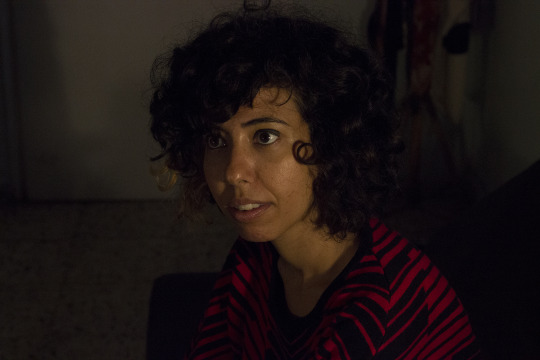
Adi Keissar, poet and founder of Ars Poetika, a Mizrahi and female-friendly poetic space in a field traditionally dominated by Ashkenazi men. Kerem-ha-Teimanim, Tel Aviv, 2015.
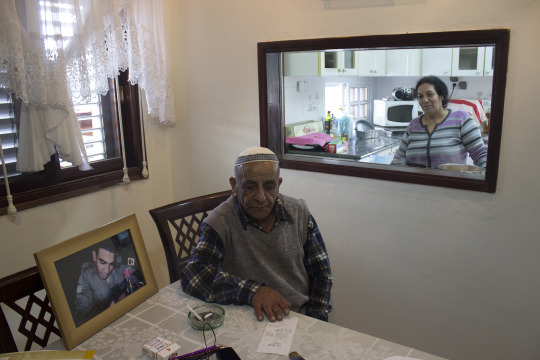
Interviewees in a Moshav Yinon, a Yemenite-majority agricultural village in central Israel, 2015.
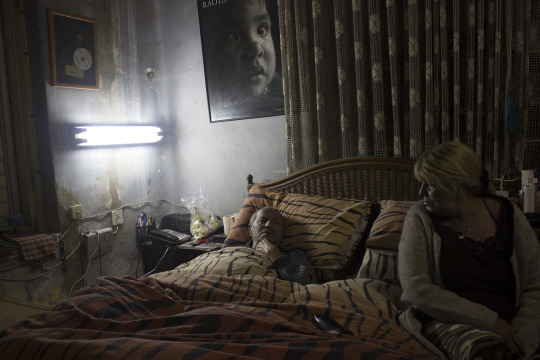
My great-uncle Moshe Meshumar. He was part of the Shubelim band, one of the earliest players in the formation of Mizrahit music, a genre that combined electric guitars with Arabic, Turkish, Greek and Yemenite elements sung in Hebrew. Shabazi, Tel Aviv, 2015.
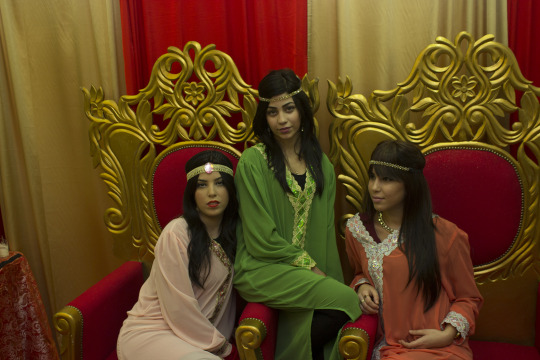
Girls dressed up at a Moroccan henna ceremony. East Jerusalem, 2014.
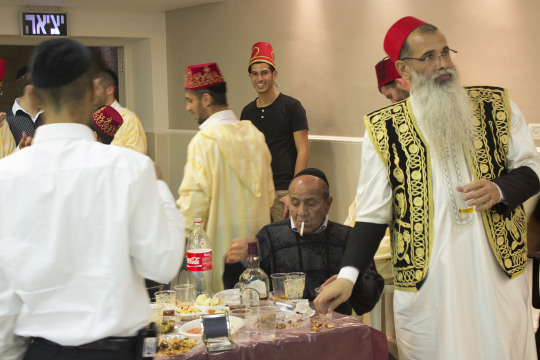
A Moroccan pre-wedding henna ceremony. East Jerusalem, 2014.
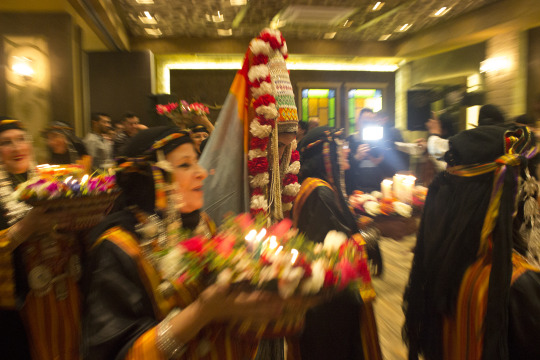
A bride wears the Tishbakh lulu (originally of the Sana'a region) and is accompanied to the hall for her pre-wedding za'afa, a ceremony comparable to the Moroccan henna. Binyamina, 2015.
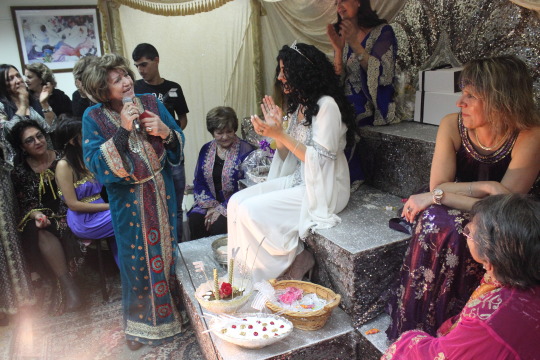
A bride's grandmother sings to her at a Persian henna celebration. Rishon Le Zion, 2015.
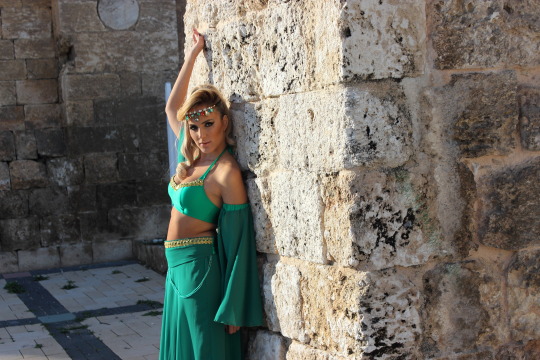
A photoshoot for a henna fashion magazine. Ramla, 2015.
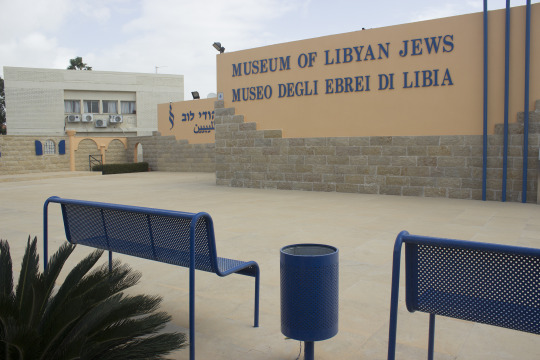
Libyan Heritage Centre, Or Yehuda, 2015.
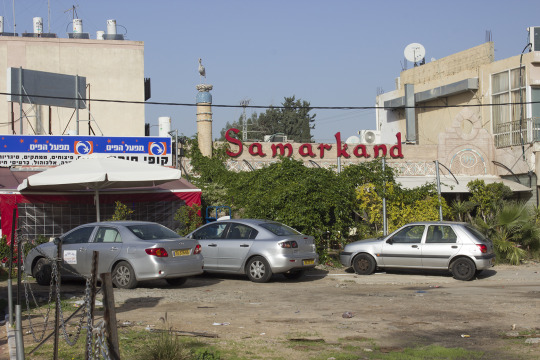
Or Yehuda, 2015.

Ohel Moshe Yemenite syangogue, Moshav Yinon, 2015.
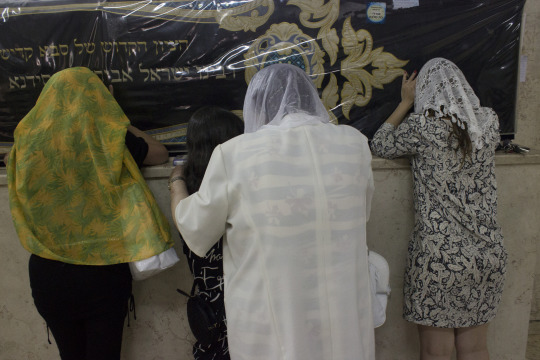
Women pray at the Baba Saleh Tomb. Netivot, 2016.
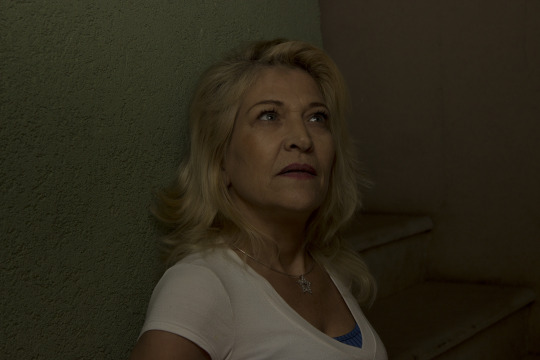
Beit Shemesh, 2014.

The shouk remains the domain of blue-collar Mizrahim and Palestinians. Carmel Market, Tel Aviv, 2015.
9 notes
·
View notes